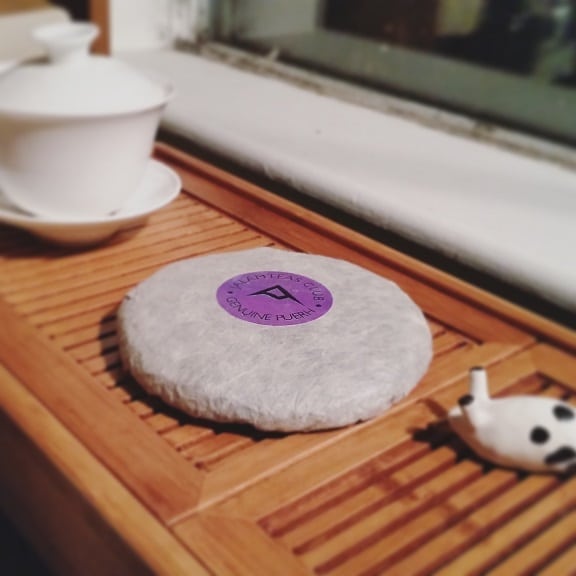Back in January, I was contacted by JalamTeas to try another one of their pu-erhs. This was different than their Nan Nuo offering because it was a loose, young sheng as opposed to a beengcha (tea cake). Well, of course, I said, “Hell yeah!” Or something akin to it. JalamTeas had a pretty good eye for pu-erh.
Then a funny thing happened…

I received the sample about a week later, dove into it right away, loved it, but sat on the write-up for it. In the ensuing weeks, I had a dream that centered around JalamTeas. To this day, I still have no idea what to make of it. I’ll let you – fine reader(s) – be the judge:
This took place at a hotel. Jeff Fuchs – and, by extension – JalamTeas were hosting some sort of symposium. They were set to unveil a new product – a Kenyan “pu-erh”. I was also in attendance.
During the event, someone stole exactly $790 worth of product from the JalamTeas stores. From the corner of my eye, I saw a hooded figure down a hallway. Why I was the only one who noticed, I dunno. Dream-related narcissism, I guess.
I dashed down the hall after the supposed thief. To my surprise, I was keeping pretty good pace with the suspect. Maybe I’m fit in my dreams. Anyway…
He made his way out an emergency exit and ascended the fire escape stairs. I followed suit, closing the gap. By the top floor, the suspect stopped. I never got a good look at the guy, but I noticed a box of tea in his hands
Then…I immediately threw him over the balcony.

And I woke up.
That was the first time I’d ever committed tea-related homicide in a dream. I must’ve really wanted to get my hands on some Kenyan heicha. Perhaps that was why I stayed away from this write-up for so long, to make sense of that quixotic dream. Then I thought, That’s not fair to the tea.
After all, as Lu Yu said (in some movie I watched once), “Tea is innocent.”
With that out of the way, I shall segue to…
Zhang Lang
This was actually the first of two such pu-erhs offered up by JalamTeas with the “Zhang Lang” name attached. Another one – a shou (or cooked) version was made available in January. The sheng (green) variant was their May release.
Both teas hailed from the Zhang Lang area near Bada Mountain, part of the greater Xishuangbanna region of Yunnan province, China. The Pulang people of the region picked and processed the leaves from medium-aged trees. By that, I mean, tea trees that ranged from thirty-to-seventy years old. Young by pu-erh standards.

Image owned by JalamTeas
The leaves for this looked like no other pu-erh (sheng or otherwise) that I’d ever seen. Strangely enough, the leaves looked…Darjeeling-ish – multi-hued layers of brown, beige and green. The smell they gave off was also vaguely grapy and herbal. I had nothing else I could compare it to. Other loose sheng pu-erhs at least gave me some clue; this was its own beast.

I went with a typical pu-erh brewing approach. I had plenty of leaves to play with, so I opted for a more traditional gongfu brew – about a tablespoon of leaves to a 6oz. gaiwan of boiled water, multiple steeps. Yes, I could’ve gone with more leaf than that, but I’m not that traditional.
Of the first three infusions – ranging from thirty-to-forty seconds (or whatever I felt like) – flavors ranged from straight grape-‘n-leaf to something akin to linden flower. By that, I mean herbal, sweet yet floral with something citrusy on the aftertaste. The experience was lingering with each cup. Spry, layered, fruity, sweet, herbal, slightly earthy, and…well…young.

Like with all young, greener pu-erhs I’ve tried, the only thing lacking was dimension. Given a half-decade or so, more nuanced and winy flavors will develop. It’s akin to watching girls grow into beautiful women. (Natalie Portman Syndrome.)This tastes great now, but I’m really excited to see what happens in the next few years.
I’d probably toss someone over a balcony for it, then.












